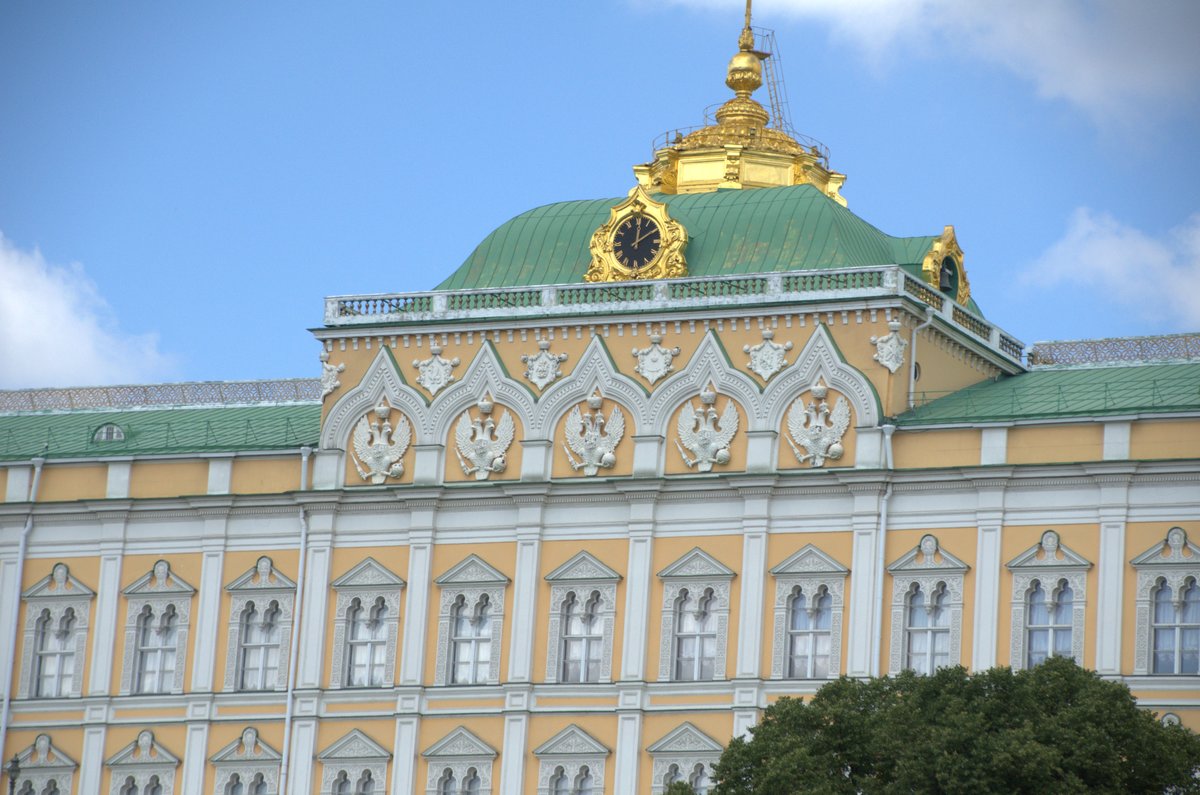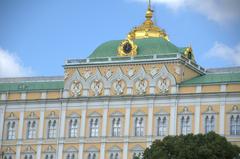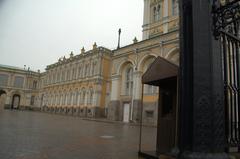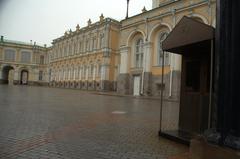
Grand Kremlin Palace: Visiting Hours, Tickets, and Historical Significance in Moscow
Date: 14/06/2025
Introduction
The Grand Kremlin Palace, majestically situated within Moscow’s Kremlin complex, is an unrivaled symbol of Russia’s imperial, cultural, and political heritage. Overlooking the Moskva River, this architectural marvel—built between 1837 and 1849 by architect Konstantin Thon—incorporates earlier structures such as the Terem Palace and the Palace of Facets. Today, it serves as the official residence of the President of Russia and a venue for major state ceremonies, offering a window into centuries of Russian history and artistry. Due to its official use, visitor access is restricted and requires careful planning, but those who secure a guided tour are rewarded with an unforgettable glimpse into Russia’s past and present (kreml.ru; designhorizons.org; Adda247).
Contents
- History and Cultural Significance
- Architectural Evolution and Highlights
- Visiting the Grand Kremlin Palace: Practical Information
- Opening Hours
- Tickets and Booking
- Guided Tours
- Accessibility
- Security and Visitor Conduct
- Exploring the Kremlin Complex and Nearby Attractions
- Tips for a Memorable Visit
- Frequently Asked Questions (FAQ)
- Conclusion and Call to Action
- Additional Resources and Sources
History and Cultural Significance
Origins and Foundations
The origins of the Grand Kremlin Palace lie in the 14th-century citadel of the Grand Princes of Moscow. The site has long been the focal point of Russian political and spiritual life, with successive rulers expanding and embellishing the Kremlin. Renaissance influences from Italian architects arrived during Ivan III’s reign, giving rise to a blend of Russian and Western styles. Surviving edifices like the Terem Palace and Palace of Facets remain integral to the palace complex’s layered historical narrative (Adda247; Advantour).
Imperial Ambitions and 19th-Century Expansion
Commissioned by Tsar Nicholas I, the Grand Kremlin Palace was constructed to embody the might of the Russian monarchy. Its monumental scale—124 meters long, 47 meters high, and over 700 rooms—was intended to impress both subjects and foreign dignitaries. The palace integrates earlier buildings, including churches from the 14th–17th centuries, into a harmonious ensemble that testifies to the continuity and grandeur of Russian statehood (Adda247).
Modern Political Role
Following the Bolshevik Revolution, the palace became the seat of Soviet and later Russian presidential power. It remains a venue for presidential inaugurations, diplomatic receptions, and state banquets, underscoring its ongoing relevance as a symbol of Russian sovereignty (designhorizons.org).
Architectural Evolution and Highlights
The Grand Kremlin Palace exemplifies a synthesis of Byzantine, Russian, and Renaissance styles. Konstantin Thon’s design features ornate façades, gilded domes, and decorative brickwork. The palace is arranged around a central courtyard and incorporates several historic structures, each contributing to the site’s unique architectural tapestry (designhorizons.org).
Notable Halls and Features
- St. George’s Hall: Used for state ceremonies, adorned with white marble and gilded columns.
- St. Andrew’s Hall: Noted for its blue and gold décor, often the site of presidential events.
- St. Vladimir’s, St. Alexander’s, and St. Catherine’s Halls: Each with distinctive color schemes and commemorative motifs.
- Terem Palace: Richly decorated interiors reflecting traditional Russian design.
- Palace of Facets: The oldest secular building in Moscow, renowned for its diamond-patterned façade.
Lavish interiors showcase gilded stucco, frescoes, and intricate furnishings, highlighting the artistic mastery of 19th-century Russia.
Visiting the Grand Kremlin Palace: Practical Information
Opening Hours
- Winter (October 1 – May 14): 10:00 AM – 5:00 PM
- Summer (May 15 – September 30): 10:00 AM – 6:00 PM
- Closed on Thursdays, and during official state events
Always check the official Kremlin Museums website for updates, as hours may change for ceremonies or holidays (TravelTriangle).
Tickets and Booking
- Advance booking is mandatory due to restricted access.
- Tickets are available through the official Kremlin website or authorized agencies (KremlTour).
- Tickets for the Grand Kremlin Palace are not included in the standard Kremlin Museums admission.
- Bring a valid passport or ID for entry.
Guided Tours
- Guided tours are mandatory; self-guided visits are not permitted.
- Tours are available in Russian and major foreign languages (English, French, German, etc.).
- Group and VIP tours can be arranged; provide full participant details when booking (TsarVisit).
- Tours typically last 1.5–2 hours and cover the main ceremonial halls and select historic chambers.
Accessibility
- Some areas are accessible for visitors with limited mobility, but historic architecture means there are stairs and narrow passages.
- Contact visitor services or tour operators in advance to discuss specific needs.
- Restrooms and basic amenities are available within the Kremlin complex, though limited inside the palace.
Security and Visitor Conduct
- Entrance is via the Kutafya Tower.
- Strict security checks apply; prohibited items include large bags, sharp objects, and weapons.
- Use the baggage storage facility near the entrance.
- Dress code: No shorts, modest attire required.
- Photography is restricted in most palace interiors—always follow guide instructions.
Exploring the Kremlin Complex and Nearby Attractions
Enhance your visit by exploring:
- Armoury Chamber: Russian regalia, Fabergé eggs, and state treasures.
- Cathedral Square: See the Dormition, Annunciation, and Archangel Cathedrals.
- Ivan the Great Bell Tower: Panoramic views of Moscow.
- Red Square, St. Basil’s Cathedral, Alexander Garden, and the State Historical Museum: All within walking distance.
(EAA)
Tips for a Memorable Visit
- Book tickets early—demand is high, especially May–September.
- Arrive at least 30 minutes before your tour for security screening.
- Dress appropriately for the season and official setting.
- Use restrooms and purchase refreshments before your tour.
- Combine your palace visit with nearby Kremlin attractions for a full-day experience.
Frequently Asked Questions (FAQ)
Q: Can I visit the Grand Kremlin Palace without a guided tour?
A: No, all visits require mandatory, pre-booked guided tours.
Q: Are children allowed inside?
A: Yes, all visitors must have tickets and adhere to security protocols.
Q: Is photography allowed?
A: Photography is generally prohibited inside most palace areas.
Q: How accessible is the palace?
A: Accessibility is limited; check with your tour provider for details.
Q: How do I buy tickets?
A: Online via the official Kremlin Museums website or authorized agencies.
Conclusion and Call to Action
The Grand Kremlin Palace stands as a living monument to Russia’s imperial grandeur, architectural innovation, and enduring political significance. Visiting this iconic site is a unique opportunity to immerse yourself in the narrative of Russian history and culture. Advance planning, guided tours, and adherence to visitor protocols will ensure a rewarding and respectful experience.
Ready to explore the Grand Kremlin Palace and other Moscow historical sites?
Book your tour through official channels and download the Audiala app for up-to-date guides, audio tours, and exclusive content. Follow us on social media for the latest travel inspiration and practical tips!
Additional Resources and Sources
- Official Kremlin Visitor Information
- Design Horizons: Exploring the Kremlin’s Architectural Heritage
- Adda247: Where Is the Grand Kremlin Palace Located?
- TravelTriangle: Grand Kremlin Palace Timings
- TsarVisit: The Moscow Kremlin Palace and the Armoury
- KremlTour: Grand Kremlin Palace Tours
- EAA: Kremlin Moscow Russia
For the most current details, always check the official Kremlin Museums website.























































































































































































































































































